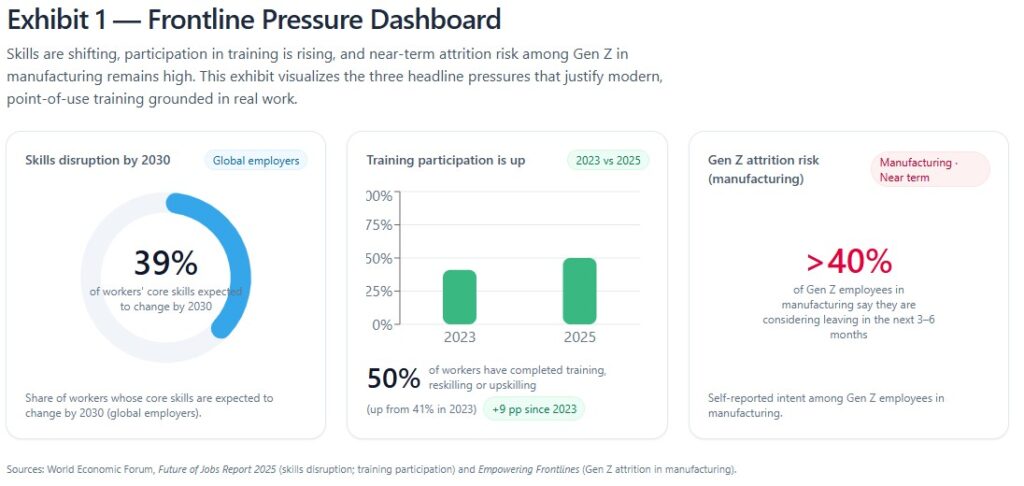Source-Linked Micro-Videos
from documents
Download the full white paper here
Executive Summary
The problem
Frontline work is changing faster than traditional training can keep up.
By 2030, about 39% of workers’ core skills will change. Employers already cite capability gaps
as the top barrier to transformation, even though training participation has risen to roughly 50%
of the workforce.
In manufacturing, more than 40% of Gen Z employees say they are considering leaving within
3–6 months. That creates a retention risk on top of the capability gap on the shop floor.
Training volumes are up. The real problem is that people still struggle to get clear, current
guidance at the moment of work.

What actually helps
People don’t need more courses. They need short, precise, up-to-date instructions they can
trust, right where the work is happening.
This white paper introduces AV Documents: short, source-linked micro-videos generated
from your approved procedures, manuals and technical drawings (often called standard
operating procedures or SOPs). When the source document changes, the AV Document
updates automatically. Where motion or “feel” matters, you add a short (15–30 second) live
insert.
The result is clear, visual, on-the-job guidance that removes the mental translation from text to
action, while keeping everything auditable.
Why we’re confident
- Video as a supplement improves learning. A large systematic review of 105
randomized trials found that adding video to existing instruction has a positive impact
on learning, with stronger effects when video supplements other methods rather than
replacing them. - Short, conversational, segmented works best. Analyses of 6.9 million viewing
sessions in massive open online courses show that short, conversational, demo-style
videos drive substantially higher engagement than long studio lectures. A separate
meta-analysis of “segmenting” reports small-to-medium gains in retention and transfer
when content is broken into meaningful chunks. - Procedural skills translate particularly well. Randomized trials in clinical and
technical settings show that video-assisted instruction can match or outperform text
first approaches for hands-on skills, and can reduce anxiety for novices. For example,
nursing students who received a short video refresher performed a standard procedure
more accurately than those with written refreshers alone. - Cognitive foundations match our design rules. Multimedia learning research supports principles like segmenting, signaling and weeding; dual-coding theory explains why pairing well-designed visuals with words helps; and classic work shows that diagrams can be more efficient than text for step-by-step procedures.
This approach is grounded in peer-reviewed research, not learning myths.
What to measure
To keep this practical, we focus on metrics that operating leaders already care about.
Primary operating outcomes
- Time-to-competence (TTC) for key tasks and roles
- First-time-fix (FTF)
- Mean time to repair/resolve (MTTR)
- Error and incident rate
- Onboarding time for critical roles
- 90-day retention, especially for new hires and Gen Z cohorts
Content health
- Time-to-coverage for new or changed procedures
- Coverage ratio (share of critical procedures with AV Documents)
- Update latency (time from source change to published AV Document)
- % content current
- Time to find the right guidance and search success rate
AV Documents remain version-linked to your controlled documents and ship in locked manifests, so it is straightforward to show that people were trained or supported on the right version when quality or safety teams ask.
Bottom line for leaders
Don’t fund more random content. Fund coverage, currency and findability—automated from the system of record.
That is how you move the needle on quality × quantity × velocity, safely.
Download the full white paper here

